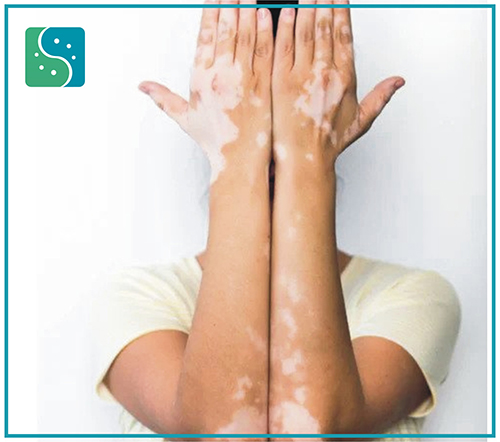VITILIGO is a long-term condition where pale white patches develop on the skin. It's caused by the lack of melanin, which is the pigment in skin.
Vitiligo can affect any area of skin, but it commonly happens on the face, neck and hands, and in skin creases.
Vitiligo is a condition that causes white patches on the skin due to loss of melanin, the pigment that gives colour to the skin. Homoeopathy is a system of medicine that treats the whole person and not just the symptoms. Homoeopathy stimulates the body’s natural healing process and restores the balance of the immune system. It stops or slows down the further destruction of melanocytes, and stimulates re-pigmentation in the existing white patches. In order to archive this, the patient is analysed on various aspects of mental, physical and familial attributes and also a complete study is done on the psychological environment that the patient has gone through in his life. The prescription is then based at the deepest level of understanding of the patient.
There are many homoeopathic medicines that are used for vitiligo that are natural, safe, and addresses the underlying concerns. The patches cause stress in many patients leading to depression, anxiety and low self-esteem. Homoeopathy takes this treatment approach and heals patients holistically.
Homoeopathy is considered a safe and effective treatment for vitiligo by many people who have benefited from it. The duration of the treatment depends on the extent of the areas in which the white patches have spread.
Vitiligo is an acquired, chronic, depigmenting disorder of the skin, in which pigment-producing cells (melanocytes) that determine the colour of skin, hair, and eyes are progressively lost. It appears as milky-white patches of skin (leukoderma) and can be cosmetically very disabling, particularly in people with dark skin.
It is currently widely accepted that vitiligo is the result of autoimmune destruction of melanocytes.
Vitiligo usually starts with a few small white macules or patches that may gradually spread over your body. Vitiligo typically begins on your hands, forearms, feet and face, but can develop on any part of your body, including your mucous membranes (the moist lining of your mouth, nose, genital and rectal areas), your eyes and inner ears.
 Sometimes, larger patches continue to widen and spread, but they usually stay in the same place for years. The location of smaller macules shifts and changes over time, as certain areas of skin lose and regain their pigment.
Sometimes, larger patches continue to widen and spread, but they usually stay in the same place for years. The location of smaller macules shifts and changes over time, as certain areas of skin lose and regain their pigment.
The amount of affected skin varies for each person diagnosed with vitiligo. Some people experience a few depigmented areas, while others have a widespread loss of skin colour.
Types of vitiligo include.
Vitiligo signs include:
Vitiligo occurs when pigment-producing cells (melanocytes) die or stop producing melanin, the pigment that gives your skin, hair and eyes colour. The involved patches of skin become lighter or white. It's unclear exactly what causes these pigment cells to fail or die. It may be related to.
The doctor will ask about your medical history and examine your skin, possibly with a special lamp. The evaluation might also include a skin biopsy and blood tests.
There are other conditions that make your skin change or lose pigmentation, including.
No, vitiligo isn’t painful. However, you can get painful sunburns on lighter patches of skin affected by vitiligo. It’s important to protect yourself against the sun with measures like using sunscreen, staying out of the sun during the hours that its strongest and wearing protective clothing.
No. Vitiligo isn’t contagious. It doesn’t spread from person to person through physical contact.
Vitiligo is a condition that causes cosmetic changes to your skin. It is common for vitiligo skin changes to affect self-esteem and make people feel insecure or uncomfortable. Homoeopathy is very effective in treating vitiligo safely and naturally. The treatment success and duration depends on the extent of the areas in which the white patches have spread. It is therefore advised to start the treatment as early as possible. A deep acting remedy is required to stimulate the body’s natural healing process and to restore the balance of the immune system. Homoeopathy stops or slows down the further destruction of melanocytes, and stimulates re-pigmentation in the existing white patches. Homoeopathic medicines also deal with the associated concerns such as depression, anxiety and low self-esteem which are very common with vitiligo. Therefore, for individualized remedy selection and treatment, the patient should consult a qualified homoeopathic doctor.